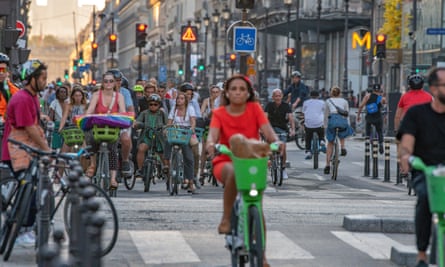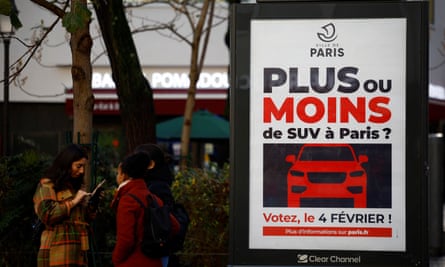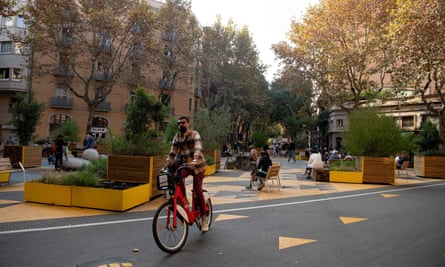
Bollards and ‘superblocks’: how Europe’s cities are turning on the car
In Paris, Barcelona and Brussels, authorities are adopting varied approaches to the task of reducing congestion and pollution
Bollards and ‘superblocks’: how Europe’s cities are turning on the car
In Paris, Barcelona and Brussels, authorities are adopting varied approaches to the task of reducing congestion and pollution
Jon Henley in Paris, Stephen Burgen in Barcelona and Lisa O'Carroll in Brussels
Mon 18 Dec 2023 00.00 EST
Most of Europe’s cities were not designed for cars. Their streets were once a place for a host of varied human activities: working, trading, socialising, playing. Getting from A to B, other than on foot, was a small part of the mix.
The arrival of the car in large numbers on European roads ended that in the 1950s. Streets were now for traffic, which must reach its destination as fast as possible … and have somewhere to park once it gets there. Cities changed, radically.
A fightback is now well under way, driven by a pressing need to cut air pollution and combat the climate crisis, and a wish to reclaim cities as pleasant places to live. Most major European cities now have schemes in place to reduce road traffic.
Strategies vary, from congestion charges, parking restrictions and limited traffic zones to increased investment in public transport and cycle lanes. Evidence suggests that a combination of carrot and stick – and consultation – works best.
Cars emit vast amounts of pollution. Road transport accounts for a fifth of EU emissions, and cars are responsible for 61% of that. With an average occupancy rate across the EU of just 1.6 people a car, they are also a hugely inefficient use of public space.
But traffic reduction policies often spark fierce resistance. For many, especially older people, cars are not just vehicles, but symbols of personal freedom and success. In several cities, attempts to restrict car use have opened a new front in the culture wars.
So for many different reasons, getting cars out of Europe’s cities is not easy. Here Guardian writers look at three: Paris, where car use has almost halved; Barcelona, where a new mayor has his doubts; and Brussels, where bureaucracy is not helping.
Paris

Parisians riding their bikes on Rue de Rivoli during the evening rush hour. The Paris mayor, Anne Hidalgo, pledged to make the city 100% bikeable by 2026. Photograph: Geyres Christophe/ABACA/Shutterstock
A startling statistic emerged in Paris last month: during the morning and evening rush hours, on representative main thoroughfares crisscrossing the French capital, there are now more bicycles than cars – almost half as many again, in fact.
The data point is the latest to comfort Anne Hidalgo, the Socialist mayor, who since she was first elected in 2014 has pursued some of the toughest anti-car policies of any major city – starting with closing the 1970s Right Bank Seine expressway to traffic.
Hidalgo has since sealed off famous streets such as the Rue de Rivoli to most traffic, created an expanding low-emission zone to exclude older cars, and established 1,000km (620 miles) of bike routes, 350km of them protected lanes.
Due in part to her policies and those of her predecessor, Bertrand Delanoë, driving within Paris city limits has fallen by about 45% since the early 1990s, while public transport use has risen by 30% and cycle use by about 1,000%.
Coming up is a limited traffic zone that, with certain exceptions, will ban all through traffic – as much as 50% of the total – from most of the city’s central arrondissements starting in spring 2024, in time for the summer Olympics.
City hall has also imposed a speed limit of 30kph (20mph) on almost all the capital’s streets, pedestrianised 200 streets outside primary schools, and recently announced a referendum on plans to charge SUV drivers “significantly more” to park.

A poster reading ‘More or fewer SUV cars in Paris? Vote on 4 February 2024’ is seen on a billboard on a street in the French capital. Photograph: Sarah Meyssonnier/Reuters
The mayor was an early and enthusiastic adopter of the “15-minute city” concept, meaning all residents’ daily needs – shopping, education, health, leisure, even, ideally, work – should be within an easily reachable 15-minute walk or cycle ride.
Pierre Zembri, a professor of urban planning and transport at the University of Paris, said Hidalgo should not, however, take all the credit for the dramatic decline of car use in Paris.
“She’s certainly been very proactive,” he said. “But car ownership has been falling of its own accord in big cities for some time. If there are acceptable alternatives – bikes or public transport – urban families are simply not replacing old cars. They don’t need another one, and it’s expensive.”
Only about 30% of Parisians now own cars, against almost 90% of the wider French population. The problem, Zembri said, is the risk that the mayor’s anti-car measures penalise delivery drivers, tradespeople and others who have to drive into the centre.
“Bike lanes are fine; the mayor’s voters love them,” he said. “But they’re not as effective a means of mass transit as buses, for example, which have been seriously neglected in Paris. And any Parisian will tell you the metro is permanently rammed.”
Zembri said Paris’s problem going forward was “not really cars, but coordination. Making sure the different transport modes coexist efficiently, avoiding massive bottlenecks just outside the city. For me, some policymaking has been symbolic.”





